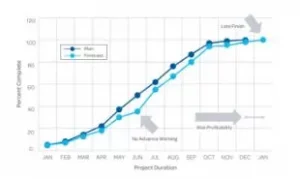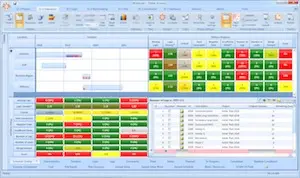True Cost of Project Delay : how to avoid it?
Cost of Project Delay : how to avoid it? For large investment projects, delays in relation to contractual deadlines can amount to several hundred thousand dollars. In fact, for an average size project, even a 10% overrun can impact the profitability of your projects. If we extrapolate this figure to the average 20% delay experienced by most projects, we get a significant loss. So, this loss will impact the company’s bottom line.
In this white paper, we explore the true cost of delays and their impact on projects. Then, we will propose an alternative solution to avoid and overcome overruns.
Summary
I- The probability of delays and cost overruns in current projects
II- The main causes of project delay
III- Getting a Slipped Project Back on Track
IV- An effective schedule
I- The probability of delays and cost overruns in current projects
You may think that the effects of a failed project are only felt at the individual project level. But the truth is that delays and cost overruns are felt throughout the company. It ripples down from the executive team to the engineers in the field. According to research by the Institute of Industry and Construction (see Figure 1), projects usually start out on track. However, a major, widespread event can impact the project, and teams will not be able to get it completely back on track. Why is this ? It is much easier to start a complex project than to finish it. And the reality is that most of the forecasts and assumptions made are not very reliable. Once a major event occurs, it becomes complicated to catch up with a situation or problem the following month, so delays are inevitable.

Figure 1 : Construction Industry Institute Project Forecast Curve
These continued time delays directly equate to cost overruns. Let’s take the example of a project with a contract value of 50 million dollars and a duration of 24 months. This represents a value per day of 68,493 dollars. Considering an average delay of 20%, the average cost of a delay is just under 10 million euros. Imagine telling your client that their $50 million project will cost $60 million. You better be prepared to answer some tough questions about how and where those costs are going to be recovered. This is difficult for project teams to manage and justify.
Physically catching up on a project requires a lot of energy, and it is sometimes very difficult to get back to the contractual deadlines as planned in the baseline schedule.
II- The main causes of project delay
There are many reasons for delaying a project, however, we retain three essential points:
1. Difficulty of communication
If you are in a very small company, communication is easier, and there are fewer intermediaries.
However, most companies are divided among several sub-organizations, where communication is sometimes difficult. The interpretation can differ from one organization to the next. Digital communication has made considerable progress in the last two decades, but this does not prevent communication difficulties between various organizations.
2. Differences in processes
In most organizations, several stakeholders may be involved in the same project, from the project initiation phase through engineering and purchasing to project control teams and/or subcontractors. Each team may use different methods and tools to perform their daily work, with different data export and reporting functions. This makes it difficult to consolidate information and get a real-time overview of the project status.
3. Lack of visibility on the project
A project can be managed without any visibility. Despite a schedule and a list of tasks defined at the beginning of the project, they are often never or rarely updated. As a result, teams do not always have visibility into the tasks that must be prioritized.
Under normal circumstances, it can take up to two weeks for medium and large companies to get the status of a single project. Why? because of the difficulties associated with organizing the project. A project manager must spend countless hours chasing down people, gathering spreadsheets, emails, and following up on incomplete or late information. And after considering the progress, it’s already time to start the process again for the next update! The problem is compounded when you realize that by the time decision makers receive the current project status, it may be too late to detect a delay or cost overrun.
III-Getting a Slipped Project Back on Track
Your project has gone off track, what should you do? You have two main options: get back on schedule or fall behind. The choice, however, is not as simple as it seems. To meet the design and construction schedule, you may have to increase resources, reduce the scope of the project, sacrifice quality, and/or approve changes. On the other hand, a delay may result in client dissatisfaction, penalty payments, a reduction in repeat orders, and/or conflict with subcontractors. The idea is to invest in a robust, good quality baseline schedule to meet the needs of the project.
IV – An effective schedule
So how do we get the planning right from the start? Consistent project success starts with a solid schedule. Deltek Acumen Fuse® can help you diagnose and resolve scheduling issues in minutes to ensure you start and finish your project on the right foot. With its advanced analytics, schedule gaps are quickly and easily identified before your baseline is released.

The tool’s reporting options will allow you to communicate with all stakeholders and track your project in real time. When combined with Deltek Acumen Risk, you can also effectively account for and proactively reduce exposure to risks and uncertainties to achieve accurate forecasts you can rely on. How do you do it ? A Monte Carlo analysis with Deltek Acumen Risk will help you mitigate risk with customized risk model designs for each project.

Deltek Acumen Risk features user-friendly reports that provide insight into the key risk factors associated with your planning tasks, allowing you to target risk mitigation efforts. The powerful Monte Carlo engine ensures maximum accuracy and unparalleled analysis of your project objectives. You can also view an overview of Deltek Acumen Risk here.
For any clarification or advice on project planning, do not hesitate to contact our services. We will take the time to discuss and support you in integrating solutions for the management of your projects, or..




